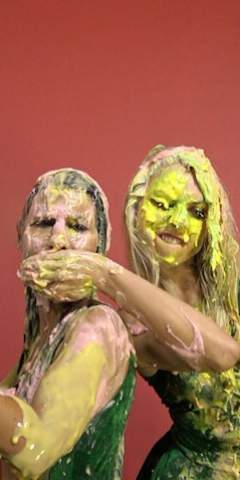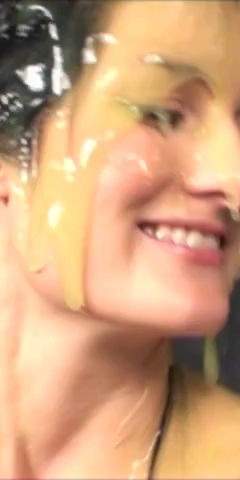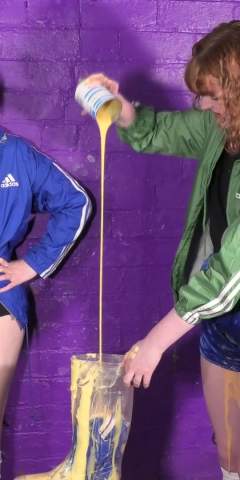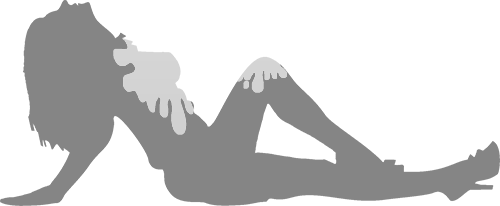How to make mud from dry clay
By TGBF
By TGBF
Posted 10/3/22 680 views
One of the first ways I was able to experience mud on my own terms was to mix dry pottery clay with water to create my own mud. Not only does this kind of mud feel amazing, but it gives you a lot of control, allowing you to tailor thickness and heat to your own personal preferences. With this in mind, and with winter depriving many of their access to outdoor muck, I figured a guide on how to make your own claymud might be useful.
First, what kind of clay to buy? In terms of type, my personal favorite is ball clay. The stuff mixes smooth, has a really nice texture when mixed well, and rinses off most surfaces fairly easily. Kaolin clay is another good option with similar upsides. That said, most "fine" dry clay should work, especially clays made for "slips" (clay and water mixed to "join" two finished pieces of pottery) should work. If you have a local pottery store and you're unsure, ask them what clays make the best slips, and they'll be able to help you out. The one clay I'd stay away from is Bentonite. I've played with Bentonite before and it's fun, but it absorbs water like crazy and needs a lot of time to settle, taking away a lot of control. Beyond that, Bentonite clogs drains like crazy, making it poorly suited for winter use.
Okay, now that we know what we're buying, let's look at where we can get it. If you have a local pottery shop, that's obviously the first place you should look. Most pottery shops sell dry clay powder for pretty cheap. Some of them even sell slip clay directly, but I prefer the control that comes with making it yourself. If you don't have a pottery store nearby, you can still buy clay online. Here in the US, theceramicshop.com is a pretty good vendor. For less than $40, you can get 20 pounds of dry clay which is enough for a few good sessions. Just be aware that they take a while and you may end up waiting around 2 weeks from order to delivery. I personally don't have a pottety shop close to me, so I buy online.
An hour to two weeks later, congrats! Your clay has arrived! Now, it's time for the tough part: setup. First, where do you want your mud bath? Realistically, like with most WAM, you want to contain your mess to the space of easiest cleanup. For me, that's my shower. The nice thing about clay is that, if you thin it out, it won't clog anything. I put a stopper over my shower drain when I'm slopping myself up and when I turn on the shower to clean myself afterwards, I just mix up the mud a bit with shower water before I pull the stopper. Again, ideally you want to contain your mess to the easiest space to clean possible. If you don't plan on getting messy near a source of water, make sure you lay some tarps down leading to a place where you can get clean. Tracking this stuff around the house is no fun.
Got everything planned out? Good. Now it's time for the mixing. First off, when mixing, wear whatever you plan on wearing to the mud bath (in my case that's nothing). Not having to clean anything extra is huge. Clay dust is also shown to sometimes cause cancer when inhaled, so I would wear some sort of a painter's mask during the mixing process to be safe. For mixing, I use a 10 liter bucket, a whisk, and a bowl that I know can hold one liter of water. First rule: add clay to water. This makes mixing much easier, prevents clumping and will lead to less wasted clay at the bottom of the bucket. I tend to do smaller sessions, so 5 liters of water is more than enough for me. I also like hot mud baths, so I make sure the water is hot to start. Once I have enough water, I slowly start mixing clay in. I personally use a large kitchen whisk for this but if you have an electric paint mixer, that'll save you a lot of work. Also, before you start the big mix, I recommend you take a small cup and experiment with different proportions of clay to water. From there, keep slowly adding clay, mixing until it's the consistency you want it. By the end, it'll be pretty hard to mix, so make sure you're prepared for that. If, by the end, you're not sure about the consistency and you want to test it, take your non-dominant hand (the one you're not using to mix) and reach to the bottom of the bucket, testing for lumps. This is also a good opportunity for you to take a small handful and smear it on yourself to see how it feels.
Congratulations! You have made a bucket of mud! Now it's time for the fun! Pour it over your head, give yourself a mud shampoo, smear it over your sensitive bits... The only limit is your imagination. Once you're ready for cleanup, if you're like me, you have the shower right there. You'll probably need to give your play space a good scrub after rinsing everything down, but that's pretty normal for WAM. Hopefully this gude is somewhat helpful. If you tried mixing your own mud after reading this, let me know how it went. I love hearing from people! Best of luck and get extra-sloppy for me!
First, what kind of clay to buy? In terms of type, my personal favorite is ball clay. The stuff mixes smooth, has a really nice texture when mixed well, and rinses off most surfaces fairly easily. Kaolin clay is another good option with similar upsides. That said, most "fine" dry clay should work, especially clays made for "slips" (clay and water mixed to "join" two finished pieces of pottery) should work. If you have a local pottery store and you're unsure, ask them what clays make the best slips, and they'll be able to help you out. The one clay I'd stay away from is Bentonite. I've played with Bentonite before and it's fun, but it absorbs water like crazy and needs a lot of time to settle, taking away a lot of control. Beyond that, Bentonite clogs drains like crazy, making it poorly suited for winter use.
Okay, now that we know what we're buying, let's look at where we can get it. If you have a local pottery shop, that's obviously the first place you should look. Most pottery shops sell dry clay powder for pretty cheap. Some of them even sell slip clay directly, but I prefer the control that comes with making it yourself. If you don't have a pottery store nearby, you can still buy clay online. Here in the US, theceramicshop.com is a pretty good vendor. For less than $40, you can get 20 pounds of dry clay which is enough for a few good sessions. Just be aware that they take a while and you may end up waiting around 2 weeks from order to delivery. I personally don't have a pottety shop close to me, so I buy online.
An hour to two weeks later, congrats! Your clay has arrived! Now, it's time for the tough part: setup. First, where do you want your mud bath? Realistically, like with most WAM, you want to contain your mess to the space of easiest cleanup. For me, that's my shower. The nice thing about clay is that, if you thin it out, it won't clog anything. I put a stopper over my shower drain when I'm slopping myself up and when I turn on the shower to clean myself afterwards, I just mix up the mud a bit with shower water before I pull the stopper. Again, ideally you want to contain your mess to the easiest space to clean possible. If you don't plan on getting messy near a source of water, make sure you lay some tarps down leading to a place where you can get clean. Tracking this stuff around the house is no fun.
Got everything planned out? Good. Now it's time for the mixing. First off, when mixing, wear whatever you plan on wearing to the mud bath (in my case that's nothing). Not having to clean anything extra is huge. Clay dust is also shown to sometimes cause cancer when inhaled, so I would wear some sort of a painter's mask during the mixing process to be safe. For mixing, I use a 10 liter bucket, a whisk, and a bowl that I know can hold one liter of water. First rule: add clay to water. This makes mixing much easier, prevents clumping and will lead to less wasted clay at the bottom of the bucket. I tend to do smaller sessions, so 5 liters of water is more than enough for me. I also like hot mud baths, so I make sure the water is hot to start. Once I have enough water, I slowly start mixing clay in. I personally use a large kitchen whisk for this but if you have an electric paint mixer, that'll save you a lot of work. Also, before you start the big mix, I recommend you take a small cup and experiment with different proportions of clay to water. From there, keep slowly adding clay, mixing until it's the consistency you want it. By the end, it'll be pretty hard to mix, so make sure you're prepared for that. If, by the end, you're not sure about the consistency and you want to test it, take your non-dominant hand (the one you're not using to mix) and reach to the bottom of the bucket, testing for lumps. This is also a good opportunity for you to take a small handful and smear it on yourself to see how it feels.
Congratulations! You have made a bucket of mud! Now it's time for the fun! Pour it over your head, give yourself a mud shampoo, smear it over your sensitive bits... The only limit is your imagination. Once you're ready for cleanup, if you're like me, you have the shower right there. You'll probably need to give your play space a good scrub after rinsing everything down, but that's pretty normal for WAM. Hopefully this gude is somewhat helpful. If you tried mixing your own mud after reading this, let me know how it went. I love hearing from people! Best of luck and get extra-sloppy for me!

Labeled n/a
| TGBF's blog & stories | Followpost | All blogs |
 |  |  |
Sponsors
Design & Code ©1998-2026 Loverbuns, LLC 18 U.S.C. 2257 Record-Keeping Requirements Compliance Statement
Epoch Billing Support Log In












